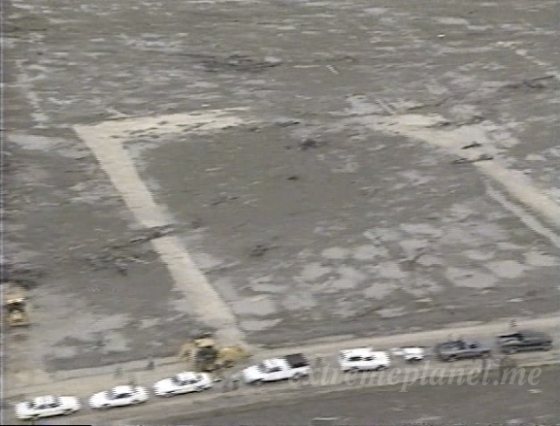
The Jarrell tornado left the most intense tornado damage ever photographed in rural Williamson County.
□ On May 27, 1997, an unusual tornado formed in the Central Texas foothills. Just after 2pm that day, despite unfavorable atmospheric conditions, two supercell thunderstorms exploded like atomic bombs in the afternoon sky. A little after 3pm, a thread-like funnel descended near the Bell County line. The tornado was weak initially, but suddenly entered a period of rapid intensification as it entered Williamson County from the north. Winds reached F5 intensity as the tornado thundered to the southwest and passed near the small town of Jarrell.
When it was over, news and helicopter crews descended upon the area, and images of the damage were broadcast across the country. Even seasoned meteorologists gasped at the intensity of the destruction. To this day, the Jarrell tornado remains unparalleled, and the damage it caused is easily the most intense ever documented.
The tornado missed the center of Jarrell, but two clusters of homes near the intersection of County Road 305 and Double Creek Drive lay directly in its path. As the tornado roared towards the area, several families fled in their cars. Others sought refuge in an underground storm shelter on the property of Gabriel Hernandez. By the time the tornado crossed County Road 308, there were 30 people above ground in the area that was soon to receive the full force of the F5 winds. On the northern edge of the damage track, a man was killed in the destruction of his home and his wife and daughter were injured (Wolf, 1997).
Nine other homes, containing 27 people, completely vanished. All but one boy perished in the obliterated homes, some of which were later found to be well-constructed. The survivor, a 13-year old boy named John Reyes, had taken shelter beneath a bed with his grandmother and brother, both of whom were killed.
“They were up underneath the bed, and the mattress started lifting up and the boys started to be pulled away,’ said Mullins’ nephew, Dwayne Meche. ‘My aunt went to reach for them, and she got lifted up, and John said he saw a board go straight through her back.” (Washington Post, 1997)
One rescue worker, who arrived within minutes of the tornado, said that he was amazed at “how quiet it was…no one was yelling for help, no dogs were barking, there were no sounds at all except rain falling on the dirt.” The effect of the F5 winds was so severe that search and rescue crews were initially unable to differentiate between human and animal remains (Hurtik, 2011). A thorough analysis of the storm’s victims concluded that all but one of the deaths occurred due to “multiple traumatic injuries,” a label often reserved for the catastrophic injuries sustained in plane crashes. The final victim died due to severe head trauma and compressional asphyxia (CDC, 1997). While most tornadoes cause a greater number of fatalities among children and the elderly, the Jarrell storm was indiscriminate and left no survivors above ground in the worst affected areas. Eleven of the dead were teenagers.
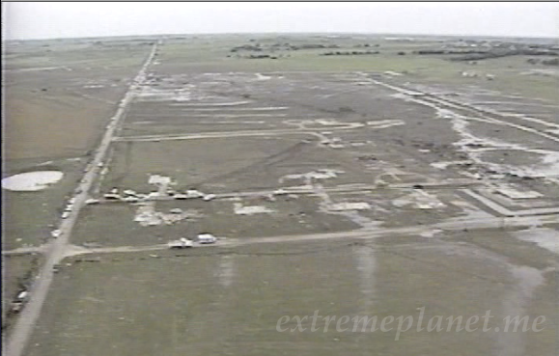
Aerial view of the damage looking due east. The Jarrell tornado moved from upper left to lower right. Five homes and a recycling plant were swept away as the tornado crossed County Road 305, leading to the storm’s first fatalities. A short time later, the tornado struck two homes at the end of a long driveway, killing all five members of the Igo family. Finally, the tornado struck Double Creek Drive (the street with the empty foundations at center). Photographic evidence indicates that the tornado only broadsided the Double Creek homes. The most pronounced ground scouring passed slightly to the south. All three survivors in the F5 damage swath were on the northern edge of Double Creek Drive – a quarter mile from the center of the tornado.

Well-built homes in the path of the tornado were reduced to bare concrete slabs on County Road 305. A mother and her teenage son were killed in the home that once rested atop the foundation at right (Brown, 1997).
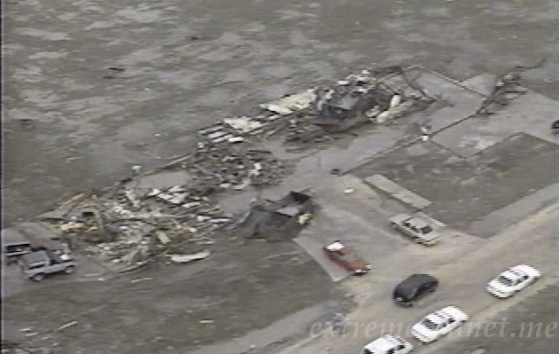
A steel-framed recycling facility at the end of County Road 307 was obliterated by the tornado. The few remaining metal support beams were twisted like pretzels. The muddy character of the landscape was the result of surface vegetation having been scoured to a depth of 18-inches.
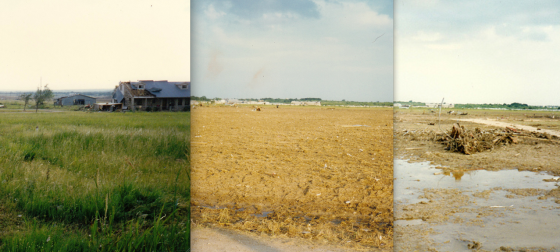
Three views of damage in the vicinity of Double Creek Drive. The image at left was taken on the fringe of the damage swath and serves as a control shot for the original appearance of the area. The image at center shows severe grass scouring at the edge of the main damage path, and the image at right shows the complete removal of all vegetation in the worst affected area. (J u n g a / flickr.com)

Photograph of a home on Double Creek Drive. According to former Jarrell resident Kurt Breit, the home where Cindie Smith and her two daughters perished was nearly identical to the home that now sits on the same lot.

View of empty foundations on the northern side of Double Creek Drive. Homes in this area were swept completely away and moderate grass scouring was noted. The worst damage (defined by extreme grass scouring) passed to the south of this area (out of frame at top). The foundation at extreme top center is where three members of the Smith family lost their lives. Ruth Carmona and her two teenage children were killed in the home with the circular driveway across the street.
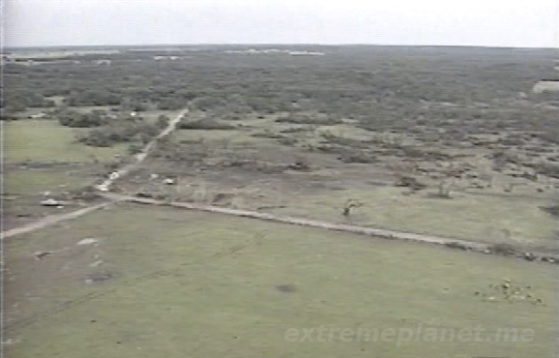
After passing over Double Creek Drive, the tornado travelled another mile before dissipating at the edge of a wooded area.

Map depicting the path of the Jarrell tornado and the location of the fatalities and survivors. The streets and homes have been edited to resemble the area as it appeared in 1997. All of the tornado’s 27 fatalities occurred on Double Creek Drive and County Road 305, including two fatalities which could not be placed in their respective homes (one article indicates a woman was killed in her vehicle, but former resident Kurt Breit reported that all of the victims were likely in residential structures). The only three above-ground survivors of the storm in the Double Creek area were on the northern edge of the primary damage path.
The Jarrell tornado defined the concept of “swept away.” Other tornadoes have left pockets of scoured pavement, but the Jarrell tornado left an unbroken swath of barren earth vacant of roads, grass, fences and the homes that once dotted the landscape. The storm completely removed trees and telephone poles in the devastated areas and pulverized the remains, leaving little for rescue workers to sift through. Surveyors also documented the disappearance of more than a dozen vehicles known to have been in the area (Grazulis, 2001). Unlike most tornadoes that cause a high number of fatalities, the tornado encountered less than two dozen homes along its 7.6 mile path (Mankowski, n.d.). The tornado was practically unsurvivable above ground, however, resulting in a disproportionately high death toll.
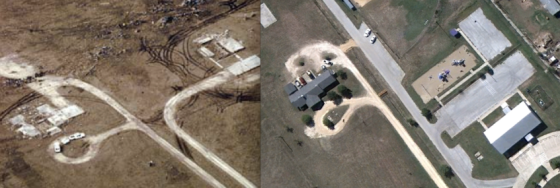
All five members of the Igo family were killed in the destruction of their three bedroom home. A playground was later built atop the vacant foundation in memoriam (visible at center right).
The homes in the direct path of the tornado were swept so cleanly away that even the plumbing fixtures and sill plates anchored to the foundations were removed (Phan, 1999). The extent of the damage made determining the construction standards of the obliterated homes difficult. While most of the homes were likely of only moderate construction, some were shown to have been well attached to their foundations. One home where three women died had heavy stone walls two feet thick (NBC, 1997). Even homes outside the zone of scoured earth were swept away.
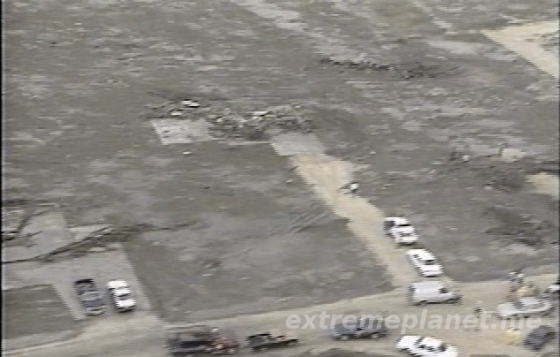
The remains of the steel recycling facility (at left), a frame home (center) and two manufactured homes (far right).
A damage survey was conducted with the little bits of information that remained, and some researchers concluded that most of the structural damage could have been caused by winds in the F3 range. The tornado’s slow movement may have exposed some of the homes in the center of the damage track to tornadic winds for three solid minutes (Grazulis, 2001). The damage survey was focused on the empty foundations, however, and not specifically on the other damage indicators. More pavement was removed in Williamson County than in any tornado in history, and the ground scouring was perhaps the most intense ever surveyed over a large area. The telephone poles in the worst affected areas were snapped a few feet above the ground – an indication of extremely violent wind acceleration. Cars and heavy wreckers were ripped apart and granulated into small pieces, and many were never found. Video of the tornado also shows extremely violent rotation comparable to other F5 tornadoes.
The tornado quite literally left no damage indicators with which to judge higher winds. It is undoubtable, however, that the tornado deserved the F5 rating it was awarded.
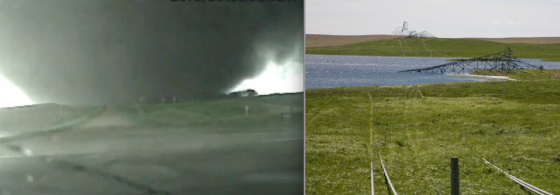
Much like the Jarrell tornado, the Bowdle, South Dakota, tornado of 2010 was over half a mile wide and moved extremely slowly, sometimes becoming almost stationary. Video of the tornado shows it was an extremely violent storm with rapid rotation, and a damage survey awarded the tornado an EF4 rating. Some storm chasers believe the tornado would have caused EF5 damage had it hit more structures. Even so, the building and vegetation damage near Bowdle (seen at right) was nowhere near as intense as the devastation from the Jarrell tornado. (Tornado video still by Randy Cooper)

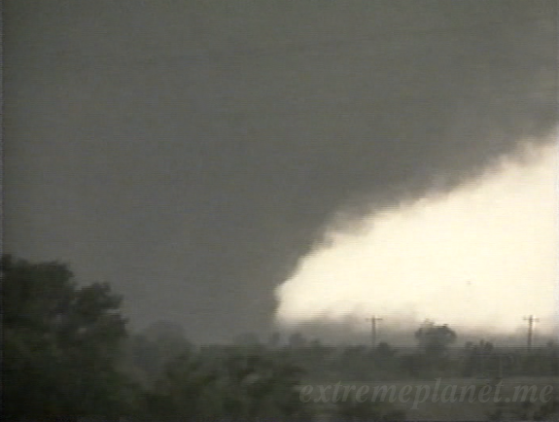
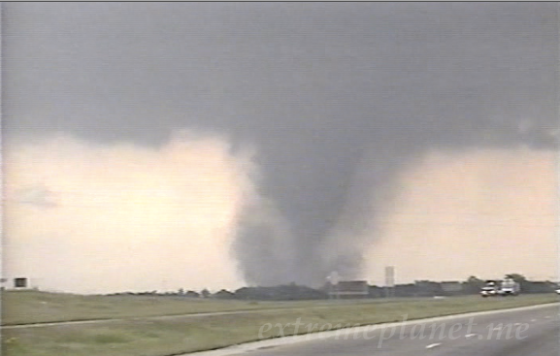
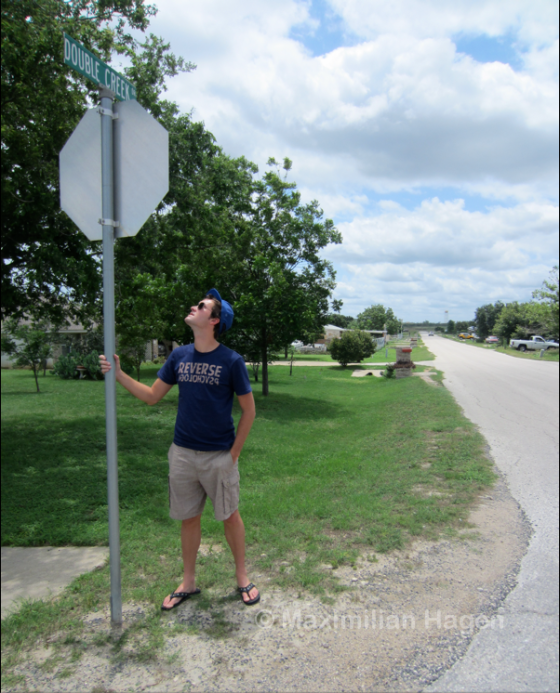
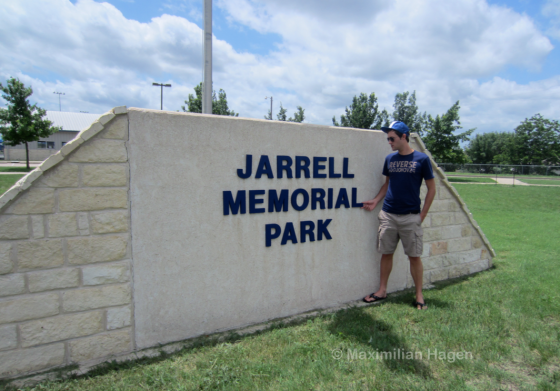
I have uploaded new footage of this tornado on YouTube. It largely consists of the storm in its rope stage not long after touchdown, but also has a good shot of it after its transition into a F5 wedge (no video of the transition itself, though). View it here:
My God! That is one of the best tornado videos I have ever seen! A jaw dropping rope expertly filmed!
This is really good footage of how the actual winds of the tornado are much larger than the visible funnel that you see. You can tell once it starts picking up dirt that it’s probably twice as big as it appears.
That’s what can get chasers in trouble because you may already be within the tornado before you realize ti’s time to go.
Amazing video though.
That kind of describes the fate of Tim Samaras.
Here’s a very detailed illustration of the damage path and where the (dearly unfortunate) victims were located. The illustration is on slide #12. If anyone can tell my where this is from and if there’s more details, I’d appreciate it.
Click to access 1997-11-v21-n1.pdf
Raymond
I know first hand how devastating that tornado was!! You see that day I lost my only sister, Cindy Moehring her husband Keith, and my two nephews Erik 16, and Ryan 15!! It is a day I will never forget!!
I’m so sorry to hear that, Kelly. Yes I’ve heard of your sister’s family and I believe the Ruiz brothers were with them. I believe Keith worked for Blue Bell. I’m here in Houston 5 counties away. My prayers and thoughts are with you and your family.
Extremeplanet: I have seen that in some of your damage overviews you would estimate a wind-speed for the particular EF-5 you are discussing, based on the damage severity. Would you be interested in estimating the wind speed be for the Jarrell Tornado?
It’s a bit harder to estimate the winds because of the tornado’s slow speed, but I’d say 280-300mph in peak gusts – probably occurring within internal vortices that rotated rapidly within the larger funnel and continued grinding over the same areas. I’d say some EF5s like the 2011 Smithville and Phil Campbell tornadoes may have had higher peak gusts (300-310mph+), but the most extreme winds would have lasted only a couple seconds.
Thanks for the reply, and the estimation. I was wondering, given the total annihilation the Jarrell Tornado brought, if the tornado had winds any stronger, (like lets say 400mph) would we be able to tell?
I’m sure winds do reach 400mph, but on a small and brief scale – like for 0.2 seconds on the side of a fast moving, rapidly rotating vortice in a Smithville/Jarrell-type tornado. Instantaneous gusts, according to some models, could reach the speed of sound (at least according to a sidebar (not included) that accompanied this article in the original magazine edition (I still own a copy).
ExtremePlanet, would 400 mph winds for just 0.2 seconds be enough time to cause extreme damage though? I believe you may have mentioned in a comment on here somewhere that winds of this magnitude would shatter reinforced buildings.
Hey Max Hi Im A Structural Engineer And Yea I Want To Get To This Point People Keep Asking You Can A Tornado Like Jarrell Texas A Very High End EF5 With 300-320 Mph Winds Knock Down Or Destroy A Modern Steel Skyscraper Level It To The Ground? Well As A Structural Engineer With A Wind Speed Over 300 Mph Which Is Well Above Most Modern Skyscrapers Factor Of Safety Ultimate Limit Wind Design And The Uplift Lateral Force On The Building And Its Corresponding Deflection Displacement Response Would Be Would Be Very Excessive So Yes Under A Direct Hit From A Tornado Like Jarrell Many Skyscrapers Could Experience A Catastrophic Failure And Suffer Either A Partial Collapse Or Total Collapse The Building Wouldn’t Be Swept Away No But Atleast A Partial Collapse Is Very Probable In A Wind Speed Like That The Skyscraper Would Have Most Of The Upper And Middle Floors The Entire Top Half Of The Building Witg The Beams And Columns Floors Would Buckle And Sag To The Lower Half Of The Building From Widespread Plastic Hinge Development From Excessive Deformation In A Tornado Like Jarrell A Skyscraper Would Be Converted To Half Of What Its Original Height Was In A Storm Like That A 1,000 Ft Building Would Be Converted To A Remaining 400-500 Ft Bombed Out Sagging Buckled Skeletal Mechanism Thats What A Partial Collapse Means In Engineering Terms But However In A Storm Like Jarrell That Is Very Slow Moving And Grinds Away For Minutes At A Steel Skyscraper With Tons Of Heavy Debris Combined With The Intense Winds/Uplift Force Multiple Times Its Not Out Of The Question Some Skyscrapers Could Be Totally Destroyed And Leveled Down to Their Foundation Footprint 100% Debris Nothing Left Standing That Could Happen In A Worst Case Very Slow Moving High End EF5 Like Jarrell That Could Happen Because Of The Excessive Debris Loading and Wind Duration And Not Just The Partial Collapse Mechanism From A Faster Moving F5 Tornado That I Described Above So Yea Modern Skyscrapers can Withstand Up To About And EF4 Tornado On The New Fujita Scale And a Moderate F4 On The Old Scale 240 Mph Winds Using a Safety Factor Of 2 But However In A F3 Or F4 Tornado A Skyscraper Wouldn’t Collapse But Would Have Massive Damage To Their Exteriors And Interiors And Would Be Left Leaning Badly to One Side From Severe Structural Deformation From Yielding Skyscrapers Are Structurally Safe Up To A F4 Tornado
Do you know what punctuation is?
Wow, that is the longest title I’ve ever read.
Pingback: Tornado by Mary Boren, Knot2bUndone
Well, by some miracle, I have finally found and uploaded a video of the long sought view of this tornado’s complete transitioning phase. View it here:
I have never seen the full footage. Thank you!
Hi Max Did U Get My Comment Above From November? Yea What I Was Saying Was As A Structural Engineer Myself And Knowing The Structural Integrity Of Modern High Rise Buildings And Skyscrapers Im Trying to Tell You A Jarrell Tornado With 300-315 Mph Winds Exceeds By large Factors The Safety Factor Design Of Most Skyscrapers In The Untied States So A Tornado That Strong Under A Direct Hit Of Skyscrapers In A City Say Chicago The Buildings Would Either Partially Or Completely Topple Over In A Sidesway Collapse Mechanism Under A Combination Of Large uplift And Lateral Forces That Will Induce A Enormous Base Bending Moment On The Buildings That Exceeds What They Were Designed For, The Frames Could Survive A Low End 200 Mph EF5 Tornado Especially If Its A Fast Moving One Where The Dynamic Amplification Would Be Of Very Short Duration To Cause Failure, So Most Skyscrapers Would suffer Either A Partial Or Total Collapse Under A Tornado Like A 315 mph slow moving Jarrell Storm That Is A Worse Case Scenario For Any Building In Any City Some Moderately Tall Buildings In The City Center May Be Shielded From The Highest Winds So They May Only Survive Since Some Of The Tallest Structures May End Up Suffering Structual Failure Where Friction 1,000 ft up And Ground Roughness Is Not A Issue For Those Extreme Winds On The Tallest Buildings Some Buildings In Some Blocks May Be Shielded From The Highest Winds It Hard to Tell Though
So I’ve never really discussed it with others, but after watching this once again, I wanted your thoughts on a issue I’ve pondered on since I initially got a hold of this video.. A timestamp would obviously be the best indicator to answer this question, but evidently one is not present in the footage, which is why I’m speculating here. With that, does this video seem to confirm that the Jarrell tornado was a continuous event–from its initial touchdown near Prarie Dell until dissipating west of Jarrell– or a series of short-lived tornadoes that led to the F5 wedge as noted in the NWS report? The chasers say there is “another one,” but assuming the time between footage jumps is short (which in reality it had to be, given the general time frame of events observed/recorded by others concurrent with the video seen here), it seems that there is a consistent debris cloud at the base of the storm where the tornado(es) are at following the vortex breakdown; up to the point where the funnel widens dramatically. Just something I’ve wanted to hear from someone else on the basis of this footage: one tornado, or a series?
Cool
Lost my Aunt and cousin in this. 1st house hit in the subdivision. One cousin not home that day. Haunted him for the last 20 years. Till he died on the highway going to work in eyes view of where his mom and brothers life was taken so many years ago. Then January I received that call a bit over a year ago I went to tx to claim the last family members body to bring home. Ever since that first call in 97 I have tracked every bit of information I can from this monster. Trying to understand how it jumped then stalled over the little subdivision and leaving almost nothing in its path taking everything and turning it to dust.
The Jarrell F5 damage is the famous, and worst damage ever compared to any F5 tornado. Bridge Creek- Moore tornado made horrible and flatten house damages, but Jarrell F5 tornado damage is well especially than Moore
That damn Jarrell tornado was a freak of nature. Cow skinned to the muscle. Blades of grass impelled in human, and animal bodies. Vehicles exploded into thousands of pieces ~ Worse than IEDs at close-range. 400+ sustained winds ~ Scientists are still scratching their heads over the real number. EF-6 needs to be considered. Our Sheriff at the time had 40+ years in multiple areas of law-enforcement. He thought he would never witness anything worse that the bodily-destruction of the federal building bombing in OKC ~ He said there was no comparison: He cried like a baby! I lost 3 friends in Jarrell that day. DNA analysis was required to determine which parts, those that were found, belonged to who. My wife’s cousin was spared: She was found 400-yards to the South of her home with minor injuries. She can recall that she jumped into a bathtub: The rest is a blank. As the saying goes, things are bigger in Texas!
Strongest winds of that Jarrell, Texas Tornado’s were every bit of 400 Miles-Per-Hour. Even maybe even exceeding that!!.. I witnessed the destruction of the great Oklahoma City Tornado of May 3rd, 1999 caused that day. Scientists measured the winds of 318 Mile-Per-Hour inside the vortex of that monster tornado. Even the great Oklahoma City Tornado of May 3rd, 1999 did not caused the absolute complete annihilation that that Jarrell, Texas Tornado did that on May 27th, 1997. Yes,… It is true that the Jarrell, Texas Tornado was moving remarkably slowly. But there been other tornadoes that have moved slowly in the course of their lives. Tornadoes have had winds that achieved the 300 Mile-Per-Hour mark. The destruction was no where complete like what the Jarrell, Texas Tornado did. The evidence is right there in photographs. Said that, like I said, I have seen what the winds well over 300 Miles-Per-Hour can do. Now someone, maybe explain to me what kind of wind on Earth a wind that is out there that can be, is, so so strong, such sheer speed, such sheer strength that it can literally rip plumbing fixtures right out of a concrete foundation that is what, maybe 2 feet thick. Because I have never seen such extreme examples of unfathomable destruction that not even the great Oklahoma City Tornado has accomplished. Remind you that the Oklahoma City Tornado’s winds were over 300 Miles-Per-Hour!!…. Same difference as if a 50 Mile-Per-Hour wind can break tree branches. Somewhere, short distance away, a 40 foot tree is found unrooted and thrown several tens of feet away and trying to say that that 50 Mile-Per-Hour wind did that?…?. No…No……No….what had happened to that 40 foot tree
only inexplicably explains only that far much stronger winds were capable of causing such a feat. Basic common sense. Common sense and logic in physics.
Tornadoes Are So Exceedingly Powerful Even Today They Are Just Estimating From The Destruction Alone. That Jarrell, Texas Tornado, What That Tornado Did That Day You Just Cannot Put A Number Nor Letter Like All The Tornadoes. That Jarrell Texas Tornado Caused Absolutely Unfathomable Destruction. Destruction, No….Not Destruction, Absolutely Unfathomable Annihilation. If There’s Ever Evidence Of Winds Stronger, Much Stronger Than 400 Mile-Per-Hour This Tornado, That Jarrell Texas Tornado Is That. Even Some Of The Whole Entire Concrete Foundations, Even They Were Ripped Out Of The Ground And Hurled Aside. 500 Mile-Per-Hour Tornado Wind!!?. Surprised?! I Will Not Be Surprised. Some Time Down The Road Someone Concluded Jarrell Texas Tornado Sustaineded 500 Mile-Per-Hour Winds.
Tornadoes Are So Exceedingly Powerful Even Today They Are Just Estimating From The Destruction Alone. That Jarrell, Texas Tornado, What That Tornado Did That Day You Just Cannot Put A Number Nor Letter Like All The Tornadoes. That Jarrell Texas Tornado Caused Absolutely Unfathomable Destruction. Destruction, No….Not Destruction, Absolutely Unfathomable Annihilation. There Was Absolutely Nothing. Nothing But A Huge Gouge In The Earth. If There’s Ever Evidence Of Winds Stronger, Much Stronger Than 400 Miles-Per-Hour, This Tornado, That Jarrell Texas Tornado Is Exactly That. Even Some Of The Whole Entire Concrete Foundations, Even They Were Ripped Out Of The Ground And Hurled Aside. 500 Mile-Per-Hour Tornado Wind!!?. Surprised?! I Will Not Be Surprised. Some Time Down The Road Someone Concluded Jarrell Texas Tornado Sustaineded 500 Mile-Per-Hour Winds.
Was the Jarrell tornado one continuous tornado, or were the Prairie Dell and Jarrell events two separate tornadoes? I keep hearing different answers, with one being the Prairie Dell tornado was more along the lines of a landspout tornado, and when it dissipated it was quickly replaced by the mesocyclonic Jarrell tornado in a hand off scenario (which I can buy but I’m not in the camp of). Another being that the Jarrell tornado was actually three separate tornadoes that merged into one (which I don’t really buy, unless by tornadoes they meant the multiple vortices congealing into one large mass). Last one (and the one I support since video supports this one the best) being that the Jarrell tornado started off as a landspout near Prairie Dell, but was ingested into a meso and rapidly intensifies into the wedge. I can see how the first theory being valid since videos and photos show the almost complete dissipation of the funnel, but the keyword is “almost.” In the videos and pics I’ve seen, the funnel still remains, and photos suggest that the debris cloud still remained, indicating unbroken contact and thus one continuous track.
In terms of windspeed, how would you compare this to other E/F5 tornadoes such as the 1999 Bridge-Creek-Moore-OKC F5, the 2011 Hackleburg EF5, the 2011 Smithville, EF5, 2011 Philly, MS EF5, the 2011 El-Reno EF5? I think the winds with this tornado were in the range of 290-325mph, while the Smithville tornado would likely be around 320-350mph. The calculation of windspeeds of violent tornadoes on the basis of damage is nearly impossible, after factoring in tornado size, sub-vortices, size of the inner-core, speed/size of the sub-vortices, whether the tornado had an eye, how large the eye was, how sharp the damage contour was, and the debris amount can all play a role in the damage a tornado produces.
I have found another video that shows the life of the Jarrell Tornado. It is the FULL UNEDITED video by the news reporters: https://www.youtube.com/watch?v=c6EhR47EM-g
Wow
Very well written, very informative article.